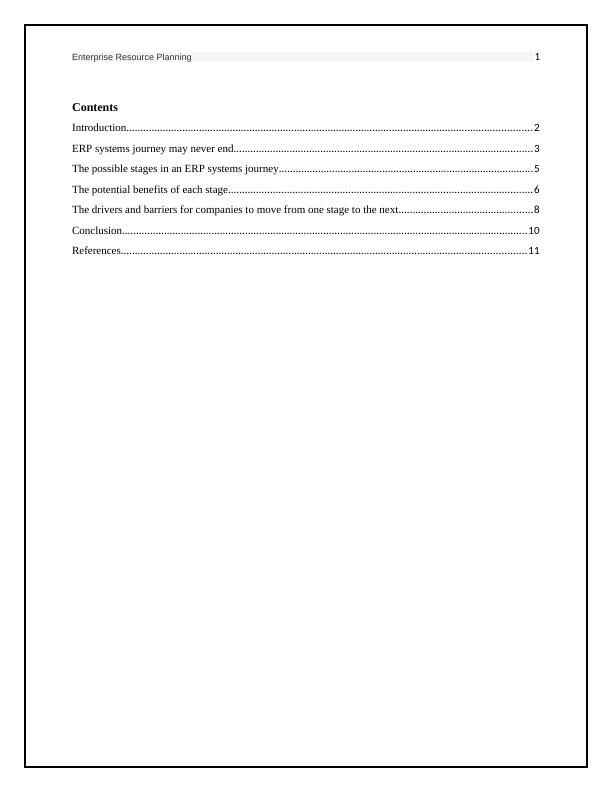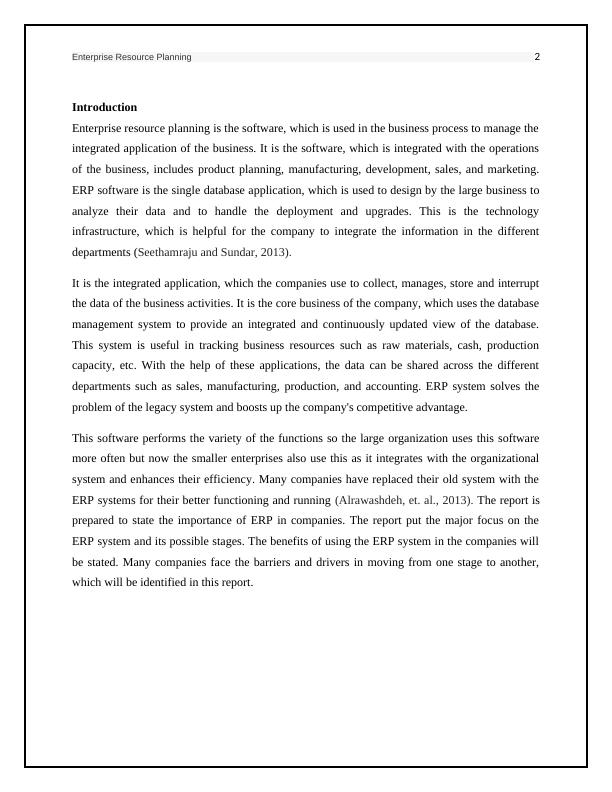Enterprise Resource Planning
Added on 2023-06-07
14 Pages4325 Words359 Views
Running Head: Enterprise Resource Planning 0
Enterprise Resource Planning
4/17/2019
Enterprise Resource Planning
4/17/2019

Enterprise Resource Planning 1
Contents
Introduction.................................................................................................................................................2
ERP systems journey may never end...........................................................................................................3
The possible stages in an ERP systems journey...........................................................................................5
The potential benefits of each stage.............................................................................................................6
The drivers and barriers for companies to move from one stage to the next................................................8
Conclusion.................................................................................................................................................10
References.................................................................................................................................................11
Contents
Introduction.................................................................................................................................................2
ERP systems journey may never end...........................................................................................................3
The possible stages in an ERP systems journey...........................................................................................5
The potential benefits of each stage.............................................................................................................6
The drivers and barriers for companies to move from one stage to the next................................................8
Conclusion.................................................................................................................................................10
References.................................................................................................................................................11

Enterprise Resource Planning 2
Introduction
Enterprise resource planning is the software, which is used in the business process to manage the
integrated application of the business. It is the software, which is integrated with the operations
of the business, includes product planning, manufacturing, development, sales, and marketing.
ERP software is the single database application, which is used to design by the large business to
analyze their data and to handle the deployment and upgrades. This is the technology
infrastructure, which is helpful for the company to integrate the information in the different
departments (Seethamraju and Sundar, 2013).
It is the integrated application, which the companies use to collect, manages, store and interrupt
the data of the business activities. It is the core business of the company, which uses the database
management system to provide an integrated and continuously updated view of the database.
This system is useful in tracking business resources such as raw materials, cash, production
capacity, etc. With the help of these applications, the data can be shared across the different
departments such as sales, manufacturing, production, and accounting. ERP system solves the
problem of the legacy system and boosts up the company's competitive advantage.
This software performs the variety of the functions so the large organization uses this software
more often but now the smaller enterprises also use this as it integrates with the organizational
system and enhances their efficiency. Many companies have replaced their old system with the
ERP systems for their better functioning and running (Alrawashdeh, et. al., 2013). The report is
prepared to state the importance of ERP in companies. The report put the major focus on the
ERP system and its possible stages. The benefits of using the ERP system in the companies will
be stated. Many companies face the barriers and drivers in moving from one stage to another,
which will be identified in this report.
Introduction
Enterprise resource planning is the software, which is used in the business process to manage the
integrated application of the business. It is the software, which is integrated with the operations
of the business, includes product planning, manufacturing, development, sales, and marketing.
ERP software is the single database application, which is used to design by the large business to
analyze their data and to handle the deployment and upgrades. This is the technology
infrastructure, which is helpful for the company to integrate the information in the different
departments (Seethamraju and Sundar, 2013).
It is the integrated application, which the companies use to collect, manages, store and interrupt
the data of the business activities. It is the core business of the company, which uses the database
management system to provide an integrated and continuously updated view of the database.
This system is useful in tracking business resources such as raw materials, cash, production
capacity, etc. With the help of these applications, the data can be shared across the different
departments such as sales, manufacturing, production, and accounting. ERP system solves the
problem of the legacy system and boosts up the company's competitive advantage.
This software performs the variety of the functions so the large organization uses this software
more often but now the smaller enterprises also use this as it integrates with the organizational
system and enhances their efficiency. Many companies have replaced their old system with the
ERP systems for their better functioning and running (Alrawashdeh, et. al., 2013). The report is
prepared to state the importance of ERP in companies. The report put the major focus on the
ERP system and its possible stages. The benefits of using the ERP system in the companies will
be stated. Many companies face the barriers and drivers in moving from one stage to another,
which will be identified in this report.

Enterprise Resource Planning 3
ERP systems journey may never end
ERP software uses the database at the same level and integrates the software solution. The
journey of the ERP was moving very rapidly. Earlier it was used only in the larger organization
but later on, it is used in the small enterprises too. The new function of the architectures of
information has also erupted. ERP systems have adopted by many companies so that accurate
information can be updated. The companies need an ERP system as they are growing so that the
proper integration among the different departments can be done (Nour and Mouakket, 2013).
The process of the company is integrated with the ERP system to grow the information system
and processes like communication, administration and the other operations of the company. It is
important for all the type of the organization whether it is big, small and large to administrate,
operate and communicate properly which can be done by this interactive software system. The
information system has been developed and there were many changes led to happened due to the
data integration and the cross-functional process (Chand, et. al., 2015).
There were many failure factors were also seen at the starting or the implementation of the ERP
such as the project management effectiveness, poor quality of the business process, improper
organization of the departments, improper consultation, and many other failures. Proper
consultation and maintenance are required in the ERP system so that the implementation of the
knowledge and the good communication system can be done (Alter, 2013). ERP system also
encourages the technical knowledge which is the major reason behind many companies are
implementing it.
The use of the ERP system by its end users is the reason behind the success of the ERP system.
In the success of the information system, the end users play a vital role as the system was both
the effective and efficient so it was accepted by most researchers. The ERP system is very much
reliable to the person and the users without any hitches this is the reason it is considered as the
efficient in the organization to use it (Mahmud, et. al., 2017). ERP system also serves the needs
of the company and fulfills the needs of its employees so it uses best in the efficiency level too.
The company uses the ERP system so that customer relationship management can also be
maintained.
ERP systems journey may never end
ERP software uses the database at the same level and integrates the software solution. The
journey of the ERP was moving very rapidly. Earlier it was used only in the larger organization
but later on, it is used in the small enterprises too. The new function of the architectures of
information has also erupted. ERP systems have adopted by many companies so that accurate
information can be updated. The companies need an ERP system as they are growing so that the
proper integration among the different departments can be done (Nour and Mouakket, 2013).
The process of the company is integrated with the ERP system to grow the information system
and processes like communication, administration and the other operations of the company. It is
important for all the type of the organization whether it is big, small and large to administrate,
operate and communicate properly which can be done by this interactive software system. The
information system has been developed and there were many changes led to happened due to the
data integration and the cross-functional process (Chand, et. al., 2015).
There were many failure factors were also seen at the starting or the implementation of the ERP
such as the project management effectiveness, poor quality of the business process, improper
organization of the departments, improper consultation, and many other failures. Proper
consultation and maintenance are required in the ERP system so that the implementation of the
knowledge and the good communication system can be done (Alter, 2013). ERP system also
encourages the technical knowledge which is the major reason behind many companies are
implementing it.
The use of the ERP system by its end users is the reason behind the success of the ERP system.
In the success of the information system, the end users play a vital role as the system was both
the effective and efficient so it was accepted by most researchers. The ERP system is very much
reliable to the person and the users without any hitches this is the reason it is considered as the
efficient in the organization to use it (Mahmud, et. al., 2017). ERP system also serves the needs
of the company and fulfills the needs of its employees so it uses best in the efficiency level too.
The company uses the ERP system so that customer relationship management can also be
maintained.

End of preview
Want to access all the pages? Upload your documents or become a member.
Related Documents
ERP Systems: Benefits, Stages, and Barrierslg...
|12
|4082
|1
Enterprise resource planning -lg...
|16
|4155
|21
Enterprise Resource Planning: The Journey of ERP in Organizationslg...
|19
|4304
|82
Enterprise Resource Planninglg...
|17
|4480
|60
Enterprise Resource Planning: Benefits, Stages, and Case Studieslg...
|21
|4848
|57
Going Live is not the end of the ERP Journeylg...
|16
|4454
|23